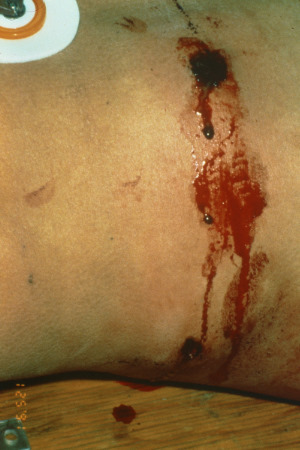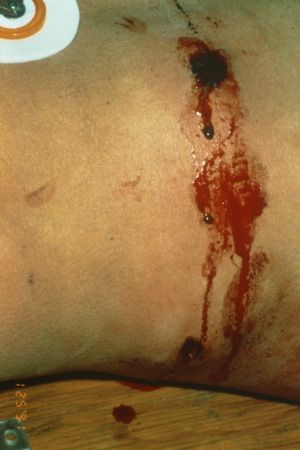Hmm, no correct answers yet. It’s all about the “location.” And what about the wooden board thing?. Hint: someone put him on the wood, and it’s an old photo. Answer Monday!

Hmm, no correct answers yet. It’s all about the “location.” And what about the wooden board thing?. Hint: someone put him on the wood, and it’s an old photo. Answer Monday!

Okay, here’s a picture of an injury. First, what happened? Then, what’s your management approach? And why are they lying on a piece of wood?!

It’s not as straightforward as you might think! Answer tomorrow.
Source: personal archive. Not treated at Regions Hospital.
We love our CT scans! They’re so high tech, with such detailed images popping up on the monitor so quickly. To take advantage of the detail, we’ve come up with fancy grading systems that can be used to direct care. But are they all they’re cracked up to be?
CT grading of spleen injury is a prime example. We’ve got a nice, detailed system that looks at laceration depth, subcapsular hematoma size and vascular injury. We can use it to predict the likelihood of needing an operation and where we should admit someone in the hospital (ICU vs ward). And when we see the injury on the screen, we believe that we can accurately apply the scoring system to these beautiful images.

But unfortunately, it’s not that simple.Scanning obtains multiple images in an axial plane and lays them out for us to look at. However, the spleen (and most other organs) and not shaped like a cube. It is curved, with complex nooks and crannies that can look like cracks. Moderate to large hematoma around the spleen can obscure lacerations. And the hilum is even more complicated and variable in shape.
Because of this, CT scans of the abdomen tend to underestimate the true extent of injury, especially in the higher grades. Grade I and II injuries are usually accurate, but in Grades III-V, the scan tends to undergrade by 1 (30% of cases) or 2 grades (45% of cases) when re-graded at surgery.
Bottom line: Grade I and II injuries are generally managed in a lower intensity setting and almost never require operation. But beware of the higher grades! It is very likely that it’s higher than you think. This means that if your patient slowly becomes tachycardic or their blood pressure softens, believe the clinical evidence. Don’t rely on a CT scan that was done hours ago that may be hiding a more severe injury than you think! (This applies to liver injuries as well)
Related posts:
Reference: Correlation of operative and pathological injury grade with computed tomographic grade in the failed nonoperative management of blunt splenic trauma. Euro J Trauma Emerg Surg – Online First 2 Mar 2012.

Frequently, radiologists and trauma professionals are coerced into describing the size of a pneumothorax seen on chest xray in percentage terms. They may say something like “the patient has a 30% pneumothorax.”
The truth is that one cannot estimate a 3D volume based on a 2D study like a conventional chest xray. Everyone has seen the patient who has no or a minimal pneumothorax on a supine chest xray, only to discover one of significant size with CT scan.
Very few centers have or use the software that can determine the percentage of chest volume taken up with air. There are only two percentages that can be determined by viewing a regular chest xray: 0% and 100%. Obviously, 0% means no visible pneumothorax, and 100% means complete collapse. Even 100% doesn’t really look like 100% because the completely collapsed lung takes up some space. See the xray at the top for a 100% pneumothorax.
If you line up 10 trauma professionals and show them a chest xray with a pneumothorax, you will get 10 different estimates of their size. And there aren’t any guidelines as to what size demands chest tube insertion and what size can be watched.
Bottom line: The solution is to be as quantitative as possible. Describe the pneumothorax in terms of the maximum distance the edge of the lung is from the inside of the chest wall, and which intercostal space the pneumothorax extends to. So instead of saying “the patient has a 25% pneumo,” say “the pneumothorax is 1 cm wide and extends from the apex to the fifth intercostal space on an upright film.”
I’ve written previously about how often imaging gets repeated once a trauma patient gets transferred to a trauma center (click here). There are many reasons, including clinical indications, need for advanced imaging (reconstructions), or lack of contrast. But at least 20% have to be repeated because the media is incompatible or not sent with the patient. Sounds like a problem, but is it a significant one?
A recent retrospective analysis of about 2,000 transfers to a Level I center looked at the reasons for repeat imaging and changes in outcome due to it. The paper found several interesting things:
Bottom line: Repeat imaging is wasteful, expensive and increases time in the ED. And don’t forget about the radiation exposure. With all the emphasis on pushing hospitals to use an electronic medical record, there needs to be a similar push to standardize methods for transferring radiographic images between hospitals to address the problem of repeat imaging.
Related posts:
Reference: Repeat imaging in trauma transfers: A retrospective analysis of computed tomography scans repeated upon arrival to a Level I trauma center. J Trauma 72(5):1255-1262, 2012.